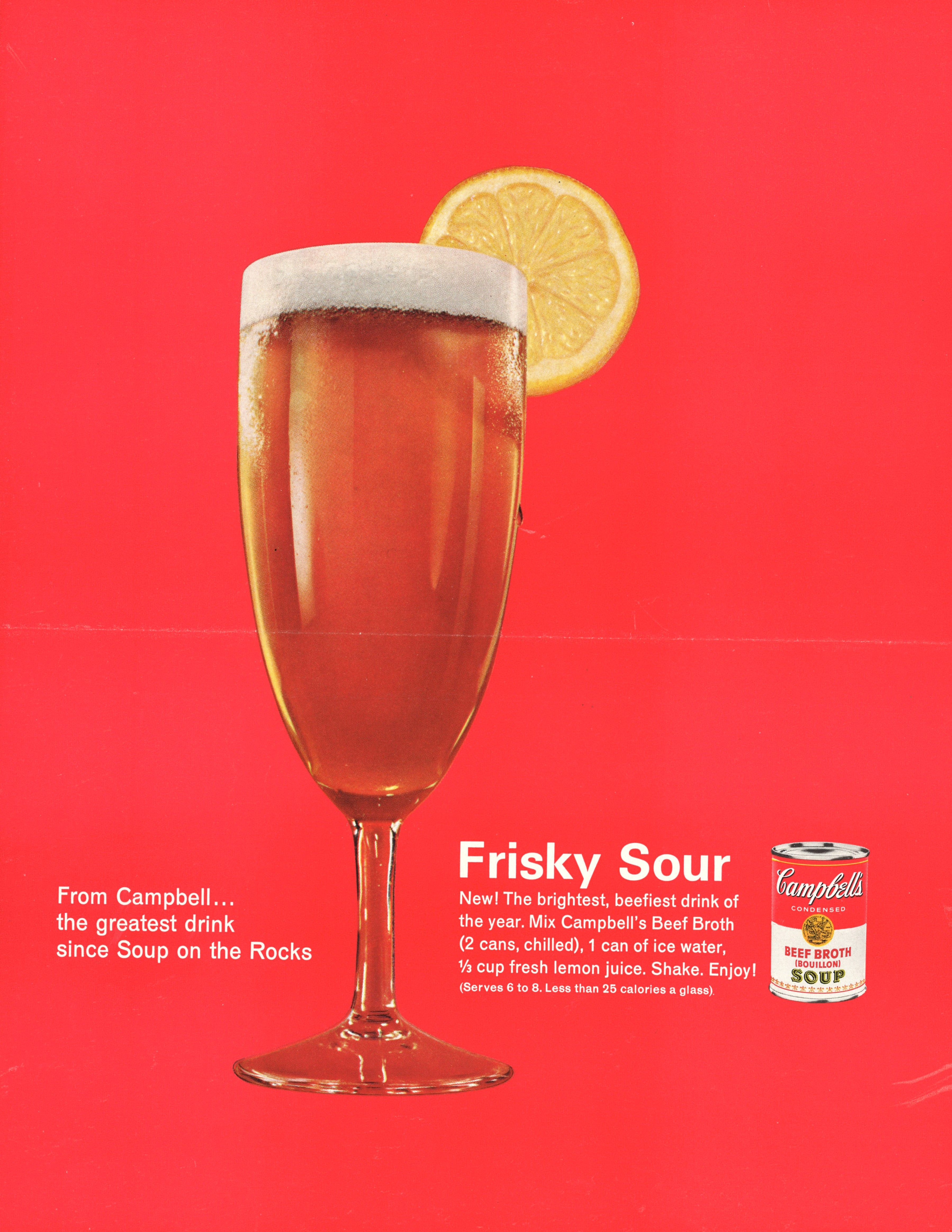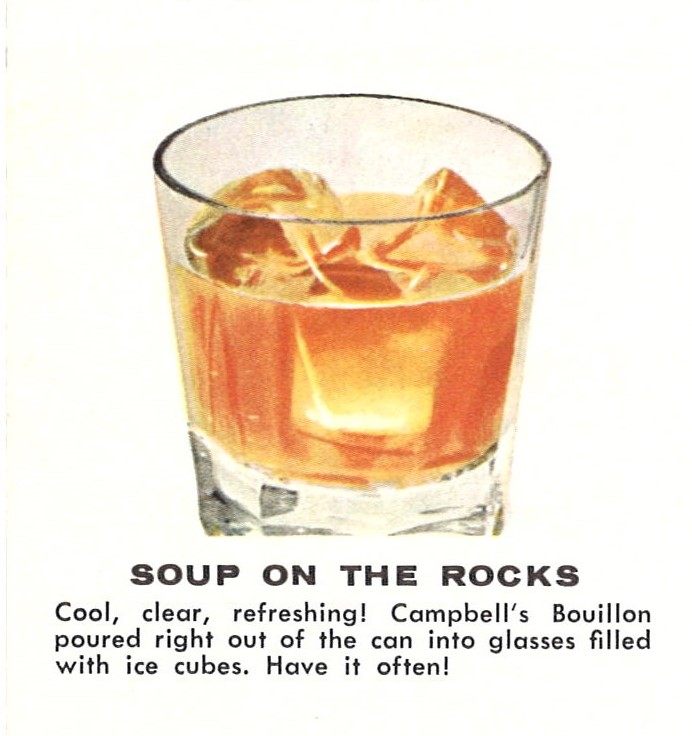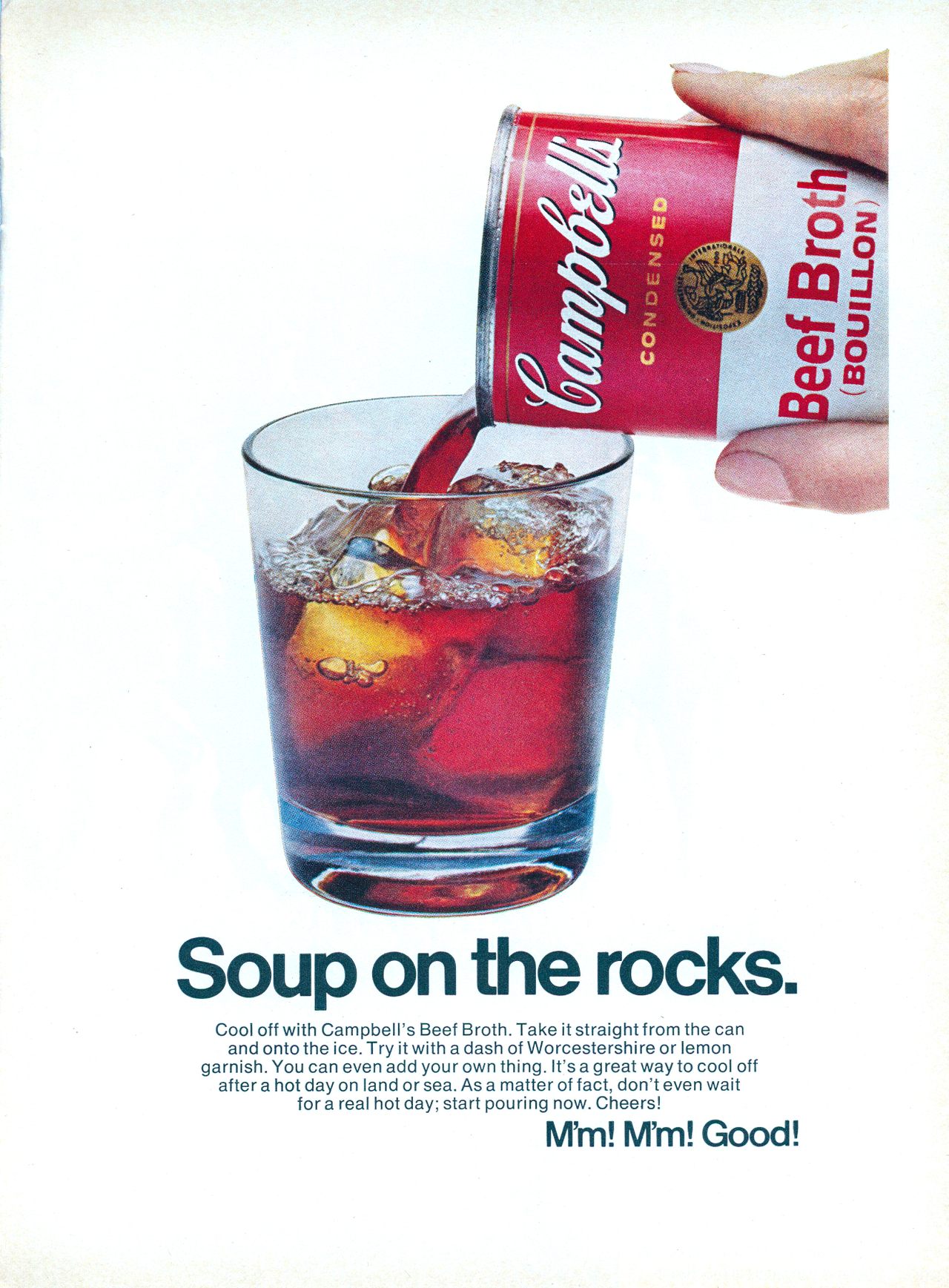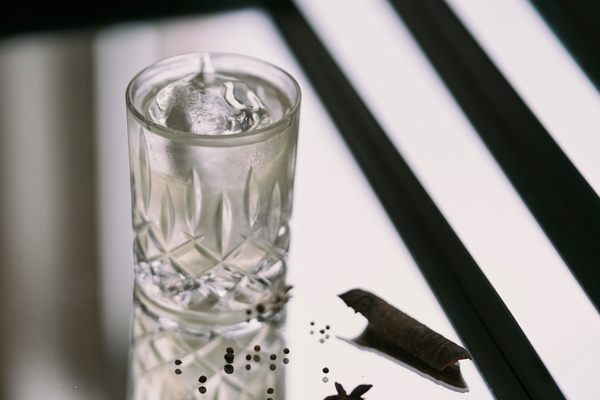Remembering When Cocktails Were Just Soup
Canned beef bouillon on the rocks, anyone?
In the dog days of the summer of 1955, hundreds of magazine editors, columnists, and radio broadcasters around the United States received an unusual cool-off care package. The contents included an ice bucket, a set of tongs, and a can of Campbell’s beef bouillon. To avoid any confusion, the gift basket also contained a recipe booklet instructing what to do with the soup: Pour it into an over-sized rocks glass and sip it like an Old Fashioned.
“For a summertime drink, it is low in calories—less than 30 calories per generous serving,” enthused a company report at the time. “It is inexpensive… It is especially valuable to athletes and golfers in replacing salt lost through exercise. Best of all, it is downright delicious.”
Don Draper might have snorted at the idea of a zero-proof libation, but Campbell’s took their “Soup on the Rocks” campaign completely seriously. In August 1955, the company rolled out a splashy ad with a color illustration of its “cocktail” in LIFE magazine. More ads followed, along with promotional gifts of Soup on the Rocks to actors and athletes, including the entire Chicago White Sox and Brooklyn Dodgers. The drink appeared on menus from the Brown Derby in Los Angeles and Sardi’s in New York.
There’s little evidence that everyday Americans were swapping their bourbon for bouillon, but the campaign still lasted well in the 1970s. By that time, Campbell’s ads included tips on how to give their drink a “kicky switch” by adding a squeeze of lemon, a dash of Worcestershire sauce, or even bitters, then garnishing it with a twist of lemon or slice of cucumber. And while Soup on the Rocks may have faded from the cultural lexicon, other broth-based cocktails with actual booze in them, such as the Bullshot, stuck around.
Curiously enough, Campbell’s may not even have been first to come up with the idea of cocktails as a way to sling their own soup. According to cocktail historian David Wondrich, it all goes back to 1952, when a PR man in Detroit was complaining about his troubles selling Campbell’s beef bouillon. Lucky for him, the man he complained to happened to be Lester Gruber, owner of the swishest cocktail joint in town, the Caucus Club. With a splash of vodka, a little Worcestershire sauce, a squeeze of lemon, and a few drops of Tabasco, the Bullshot was born.
“Ox on the Rocks,” as it was sometimes known, enjoyed a mild spurt of popularity as an oddity—mostly as a “freak drink.” Joan Crawford was apparently a fan, although Marilyn Monroe, according to Wondrich, said “what a horrible thing to do to vodka.”
Bizarre though the Soup on the Rocks campaign may now seem, it makes more sense in the context of the spaghetti-on-the-wall approach that many companies of the era took to marketing. “Advertising at that time, because it was so relatively cheap and diverse, was less centralized than it is right now,” says Christina Ward, author of American Advertising Cookbooks: How Corporations Taught Us to Love Bananas, Spam, and Jell-O. “So that’s why you see just so much advertising, especially for the big companies, and they can try out different concepts.”

Underneath that blanket experimental approach, however, Ward points out that Soup on the Rocks fits into a much longer running American narrative. “The larger arc of the history was about nutrition and calories,” she says. During the early 20th century, calories were a good thing that was often in short supply. Between the Great Depression and strict rationing during two World Wars, most Americans welcomed an economic way to fill their bellies. “Workers needed calories, and starvation wasn’t too far off. So a condensed soup was a really cheap way to get caloric intake.”
All that started to shift in the post-war landscape, when women returned home after manning the factories. All of a sudden, the aspirational housewife became the focus of much of American advertising. “If you look at the 1947 Dior collection, it comes back to lots of extra fabric with the big, poofy skirts nipped at the waist,” Ward says. “All of fashion followed that, and thinness became again a cultural norm.”
American diet culture was nothing new in advertising. Even in the 1920s, cigarette ads had urged women, “For a slender figure, reach for a Lucky [Strike] instead of a sweet.” In the 1950s, however, it kicked into high gear. At the same time, domestic science, sometimes referred to as home economics, was gaining influence. Largely led by women chemists and social reformers, the movement sought to use scientific principles to optimize the American diet. And while the concept of calories had been around since the mid-19th century, all of a sudden the idea of a quantifiable approach to nutrition took on a whole new appeal.
“Everybody takes off with every idea, some well intentioned, some pure quackery, about how to improve health,” Ward says. “Then with women, specifically, guilt and shame about not giving your family the most healthy food.”
Needless to say, replacing a glass of hard liquor with almost anything would be a nutritional improvement, but there were other reasons that broth played right into post-war America’s obsession with nutrition and dieting.
“[Soup on the Rocks] was marketed towards that health crowd,” Ward says. “Now, the other underlying cultural norm of that time was still left over from the Victorian era, which is the idea of sick-bed food. And broth was always considered something that is easily digestible and nutritious.”
Like General Mills and Betty Crocker, Campbell’s was large enough to have its own in-house home economics department and test kitchen. Over the decades, its cooks would go on to create some of the most iconic recipes of the 20th century. The most notable success was Dorcas Reilly’s green bean casserole, which now graces so many Thanksgiving tables, although there were plenty of other hits, including a version of the Depression-era recipe for cake with canned tomato soup.

But for every smash, there were plenty of flops. “For every green bean casserole, there’s 20 bad ideas,” Ward says. Whether or not you think of Soup on the Rocks as one of those, the company continued to double down. In 1962, Campbell’s rolled out ads for the Frisky Sour, which it declared “the best thing since Soup on the Rocks.” Shown in a Champagne flute like an aperitif, the drink consisted of two cans of beef broth, one can of water, and a half cup of lemon juice, shaken.
Incredibly, Campbell’s has been trying to make Soup on the Rocks happen for nearly 70 years now. Then in 2021, Campbell’s Canada threw the teetotalling sensibilities to the wind with a series of “brothtails,” including the Pork Ramen Mezcal Margarita, the Mushroom Truffle Daiquiri, and the Thai Chicken Negroni. The latter, which contains both canned chicken broth and chicken broth ice cubes, enjoyed a moment of viral fame, albeit mostly as an “abomination.”
“When Campbell’s Canada came out with a Thai Chicken Negroni, everyone on bartender social media went crazy,” says Jazzton Rodriguez, a cocktail consultant. “Everyone was completely against it. I was like, ‘I’m going to lean into this hardcore.’”
Rodriguez had been toying around with the idea since 2018, when he released a series of hot, spiked broth-based drinks. “Basically, I wanted to drink a soup that also had that backbone and heat from alcohol,” he says. “I had some success making those hot brothtails and everyone was either super into it or super against it—which is fun.”

Then in January 2023, he dropped a recipe for a Chicken Soup Martini on his Instagram account, only to watch it promptly go viral. The drink includes chicken bouillon and mirepoix-infused gin. “I’ve always been into culinary cocktails and basing cocktails off food memories I have,” he says. Since then, a number of people have reached out to him to report making the drink at home. “The two big mainstream savory cocktails are Bloody Marys and Dirty Martinis. So the Dirty Martini was my Trojan horse to get the broth thing across to people.”
Perhaps Soup on the Rocks was simply before its time. In light of the growing interest in savory cocktails with everything from miso to MSG, a cold glass of beef stock no longer seems so outlandish. Punch announced in 2022, “The Bullshot is back, baby,” with bartenders at the current iteration of the Caucus Club garnishing their spiked meat juice with candied bacon, just for good measure.
“It definitely still takes a bit of balance and skill so you don’t get into weird territory,” Rodriguez says. But when it works, it works. “I think it’s really cool that people are becoming more accepting of drinking boozy soup.”
Soup on the Rocks
Courtesy of Campbell's
- Prep time: 2 minutes
- Total time: 2 minutes
- 1 serving
Ingredients
- 1 10.5-ounce can beef broth, preferably Campbell’s
- Ice
- Twist of lemon (optional)
- Worcestershire sauce (optional)
Instructions
- Pour the Campbell’s beef broth right out of the can and onto the ice. Take it straight straight or add a dash of Worcestershire sauce for a kicky switch. It’s a great way to cool off on a hot day.
Notes and Tips
Soup on the Rocks is very literally what the name promises. Despite the fact that the drink includes two ingredients, one of which is ice, Campbell’s still included a “recipe” in their advertising. The following is adapted from a 1972 ad that ran in LIFE magazine.
Chicken Soup Martini
- 4 servings
Ingredients
- 30 grams minced carrot
- 30 grams minced onion
- 30 grams minced celery
- 10 grams extra virgin olive oil
- 8 ounces gin
- ½ tablespoon concentrated chicken bouillon (such as “Better Than Bouillon”)
- 4 ounces hot water
- Big pinch of kosher salt
- Pinch of MSG
- 20 grams of kosher salt
- 3 ounces water
- ½ ounce Manzanilla sherry
Instructions
-
Gently sauté the carrot, onion, and celery in olive oil on medium heat until the mixture is fragrant and the onion is translucent, about two to three minutes.
-
To make the mirepoix gin: Place the mirepoix in a sealable container with the gin. Allow it to infuse overnight before freezing and strain. Freezing before filtering allows the oil to solidify and makes it easier to strain from the liquid.
-
To make the chicken bouillon brine: Combine the chicken bouillon, salt, MSG, and hot water in a bottle. Stir to dissolve, then refrigerate until chilled.
-
To make a saline solution: Dissolve 20 grams of kosher salt in three ounces of water. Stir until well-combined and set aside.
- To make one martini: Add two ounces of strained mirepoix gin, ½ ounce sherry, ¼ ounce of the chicken bouillon brine, and two to four drops of saline solution to a mixing glass. Stir the mixture over ice for 15 to 20 seconds, or until everything is very cold and diluted to taste. Strain into a chilled coupe glass and serve and garnish with a few drops of high-quality extra virgin olive oil, if desired.
Notes and Tips
Jazzton Rodriguez’s more modern version of a boozy soup requires several steps, but results in a highly complex, savory cocktail.
Gastro Obscura covers the world’s most wondrous food and drink.
Sign up for our regular newsletter.


















Follow us on Twitter to get the latest on the world's hidden wonders.
Like us on Facebook to get the latest on the world's hidden wonders.
Follow us on Twitter Like us on Facebook